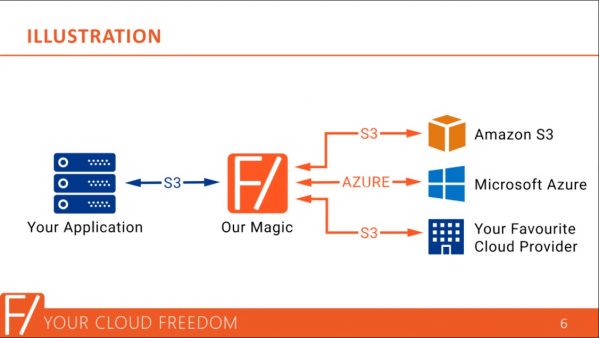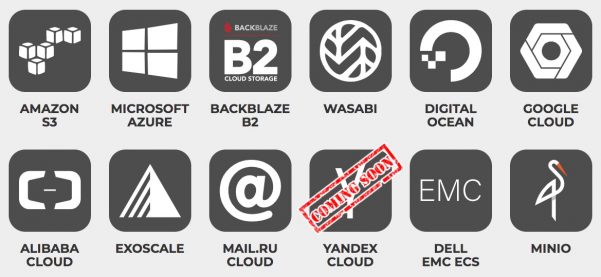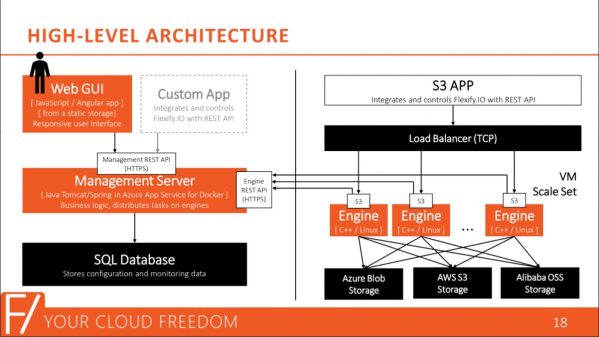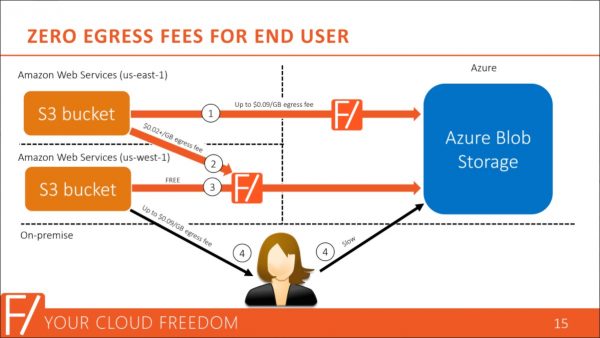Flexify.IO Promotes Universal S3 Gateway
For multi cloud access with homogeneous method
By Philippe Nicolas | September 22, 2020 at 2:22 pmMulti-cloud is a reality, a need and an objective for many users. A reality because we live in a world with multiple players – 3 or 4 cloud giants with AWS, Azure, GCP and Alibaba and many second tier ones -, a need as users refuse to be locked-in, and an objective as the choice made one day could be different another one. The main idea is to be cloud agnostic considering the cloud as a journey, not a location, becoming a strong resilient commodity.
On the storage side, historically cloud computing meant cloud storage and AWS initiated the wave with S3 in 2006, the de facto cloud storage standard, wherever it resides, on-premises or in the cloud. Considered as a standard it forced many players to offer alternatives still with S3 with other cloud-based offerings or even on-prem ones. This is the strength and characteristic of a standard, being promoted, adopted and used by everyone. But some resist and have the size to resist like Azure or even GCP and finally different philosophies create friction. At the end, the market is right and shows reality and users’ adoptions.
So the question is how to help users and potentially software vendors and even cloud operators to promote migration to their platform or just the addition of a new cloud entity in an existing environment and make the multi-cloud a reality and move seamlessly.
And this is exactly where Flexify.IO fits. We wrote 2 years ago (January 2018, June 2018 and December 2018) about this company.
It is a recent self-funding player, founded in 2015 by Sergey Kandaurov, CEO, Sergey Smirnov and Alexey Schepetkov. Majority of the team, less than 10 people, is working remotely even if the company has 2 offices in Nizhniy Novgorod, Russia, and Plantation, FL.
The idea is to provide a rich data access virtualization platform, based on S3, connected to on-premises and public clouds object storage. The result is obvious: users can run their S3-based applications everywhere contributing to make the cloud a commodity. A way to illustrate Flexify’s solution is to understand that it virtually creates a cloud of clouds.
The first public prototype was unveiled in March 2016 and the first release reached the street in December 2017. The current release is 2.11 and updates arrive every 3 or 4 weeks.
The example illustrated below summarizes well the value proposition. For Azure, it’s obvious as there is no S3 compatible API like on GCP or others.

The firm targets seven use cases:
- Cloud to cloud migration
- On-premises storage to cloud migration – object to object or file to object
- Data Rrepatriation
- Keep access during migration (during adding new cloud target)
- Add cloud with data splitting
- Replicating data across clouds
- API translation across incompatible clouds

Next product iterations should offer add de-dupe and copy management features.
In terms of architecture, the engine is completely stateless and scales linearly.

The product exists in 3 modes:
- SaaS: a subscription-based service, the easiest to start with.
- On-Prem: a licensed software allowing companies with strict security or performance requirements to self-host Flexify.IO either in their own data centers or cloud accounts.
- Flexify.IOCE: a free community edition limited to a single machine for small-scale projects.
The pricing model is primarily a consumption one with $0.02/GB of traffic to partner storage providers. For on-premises/self managed deployment, it is charged per-component in perpetual or subscription licenses: $2,500 for the management server and $1,000 per engine. Enterprises licenses seem to be also a way to consume the service.

The go-to-market leverages cloud service providers to help them switch users to their platform without changing anything on the customer side. In a second phase, adding another cloud to an existing environment reinforces the multi-cloud effect completely transparently. The company has signed several customers like AK Productions or other big names in oil and gas, electronics and retails vertical segments. And also, worth to mention, Dell EMC is already a Flexify partner having already deployed many times the service.
Backblaze for instance leverages Flexify to migrate data from AWS to B2. If you check this link on their homepage, Flexify is the solution behind. Wasabi has a clear explanation page on how to use Flexify to migrate users’ data into their cloud. This is also the case for DigitalOcean.
Cloud giants have also jumped into that segment acquiring various migration players such as CloudEndure for AWS, Velostrata for GCP and Mover.IO for Microsoft. These Internet companies continue their journey with a clear wish to swallow all data. This is exactly what AWS Snowball or Azure Data Box do or indirectly AWS Outposts or Azure Stack.
On the competition side, we can consider for limited use cases players described above, in addition to these names, we can list NooBaa, acquired by Red Hat in 2018, Acembly, MinIO or DepSky. Komprise, Data Dynamics, StrongBox Data Solutions and DBM Cloud Systems could be added here as well but they don’t cover all use cases listed above.
This cloud approach reminds what the industry developed many years ago within the enterprise with vendors like Acopia Networks (acquired by F5 Networks), NeoPath Network (acquired by Cisco, NuView (acquired by Brocade then Data Dynamics), Rainfinity (acquired by EMC), Attune Systems (IP acquired by F5) or AutoVirt with the Network File Virtualization and Network File Management. We can add the block mode to this with StorageApps, DataCore, StoreAge, FalconStor or EMC Invista. Same remark for CDP offerings that reside within the network. Very often, the industry continues to reinvent itself with past ideas… it’s a bit the case here.













 Subscribe to our free daily newsletter
Subscribe to our free daily newsletter


